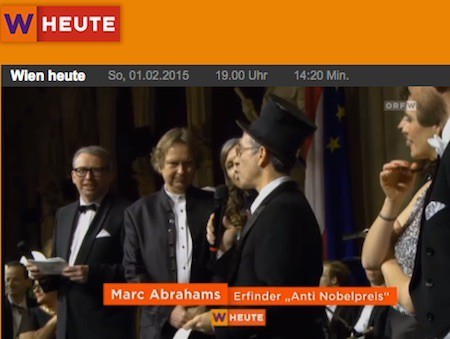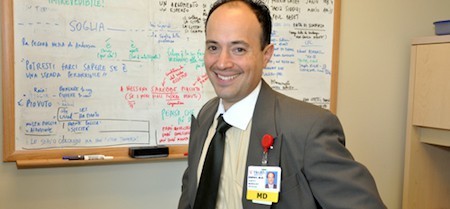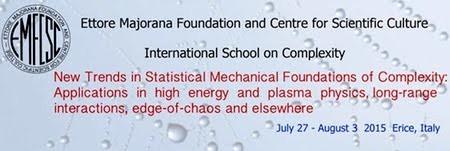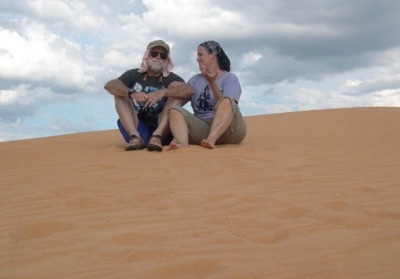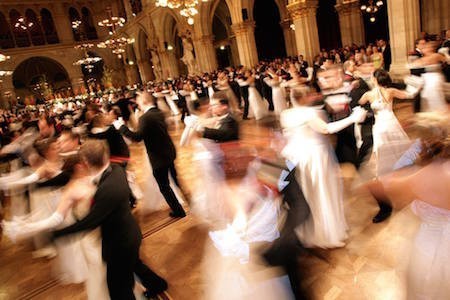Marc Abrahams's Blog, page 349
February 1, 2015
A 24/7 lecture for the Vienna Ball of Sciences
The first Vienna Ball of Sciences, held last night, was a roaring success, with the more than 2500 (the tickets sold out quickly) scientists, friends, and admirers exhibiting both brownian motion and traditional Viennese-waltz motion in strolling, dancing, chatting, sipping and noshing their way through the elegant ballroom and reception chambers of Vienna’s city hall, from 8 pm till 4 am.
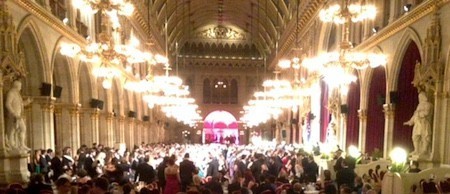
The ball established itself as one of the (few) truly social, got-to-be-there events for the international science community, and for a hearty slice of Vienna’s social, political, and art haute monde.
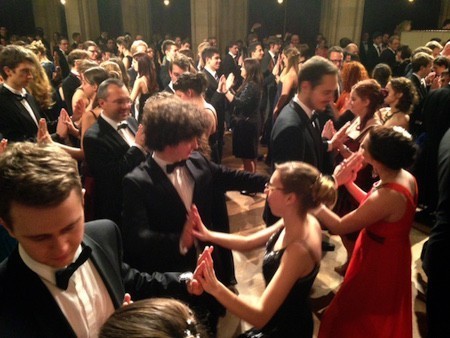
I played a small role, interviewing Katharina Gsöllpointner, Helmut Veith, and Jörg Schmiedmayer on stage, then performing a 24/7 Lecture, at midnight, on the topic “The influence of Vienna on science”. Katharina Gsöllpointner, Helmut Veith, Jörg Schmiedmayer, Barbara Blaha, and Florian Freistetter (who was also live-blogging the ball) jointly acted as a human clock mechanism, to enforce the 24-second time limit. Here is the text of my 24/7 Lecture:
IN 24 SECONDS:
Scientists of Vienna!
SCHOEDINGER saw the waves, the rhythms, the dance-like qualities of elementary particles.
PAULI predicted that the parts of an atom prance in exclusive ways.
LORENZ learned that animals live in tune with their natures.
HEDDY LAMARR was hip to frequency hopping.
FREUD and his friends — who WANTED to be scientists — theorized a taxonomy of tangos in people’s heads.
IN 7 WORDS:
Vienna inspires scientists to merrily, mentally waltz!
Here’s a photo of Katharina Gsöllpointner, at the mayor’s reception that opened the ball, donning the ceremonial Ig Nobel chapeau claque, which traveled with me from Cambridge, Massachusetts:
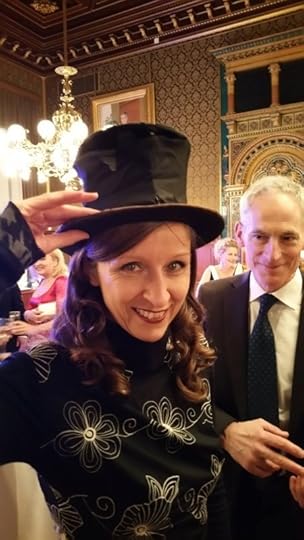
Here’s Helmut Veith explaining his favorite big scientific mystery (not the orchestra behind us, drinking in the mystery):
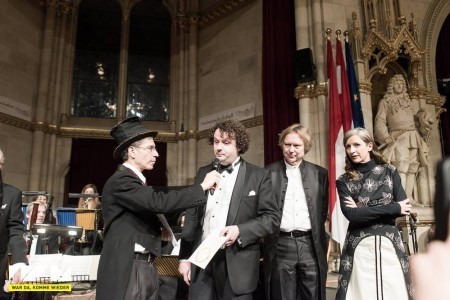
Here’s Jörg Schmiedmayer explaining his favorite big scientific mystery (that’s Oliver Lehmann, the ball’s head organizer, at left):
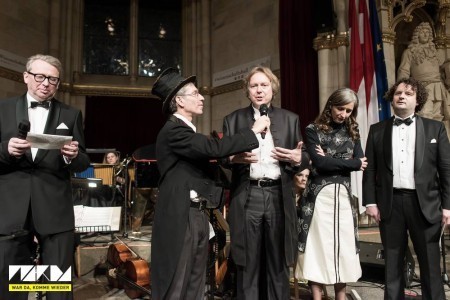
Congratulations, and a big thank you, to Oliver Lehmann, Katarina Singer, and the entire team and supportive supporters who created the Ball of Sciences from a universe that was, previously, lacking this certain something.
BONUS: Here’s an ORF television report from the ball. It includes video of the “7 words” portion of the 24/7 Lecture:
BONUS: There are lots more photos on the Warda site and on the Wissenshcaftsball site.
January 31, 2015
Cheap quasi-repeat of a dear study of cheap-versus-dear fake medicines
A new, celebrated medical paper echoes the beloved study that long ago earned an Ig Nobel Prize for medicine. The Los Angeles Times summarizes the new study, with the headline:
“‘Expensive’ placebos work better than ‘cheap’ ones, study finds“.
The new study is:
“Placebo effect of medication cost in Parkinson disease,” Alberto J. Espay [pictured here], MD, MSc, Matthew M. Norris, MEng, James C. Eliassen, PhD, Alok Dwivedi, PhD, Matthew S. Smith, BS, Christi Banks, CCRC, Jane B. Allendorfer, PhD, Anthony E. Lang, MD, FRCPC, David E. Fleck, PhD, Michael J. Linke, PhD and Jerzy P. Szaflarski, MD, PhD, Neurology, epub January 28, 2015.
The 2008 Ig Nobel Prize was awarded to Dan Ariely of Duke University, Rebecca L. Waber of MIT, Baba Shiv of Stanford University, and Ziv Carmon of INSEAD for “demonstrating that high-priced fake medicine is more effective than low-priced fake medicine“. The team described their discovery in a 2008 paper:
“Commercial Features of Placebo and Therapeutic Efficacy,” Rebecca L. Waber; Baba Shiv; Ziv Carmon; Dan Ariely, Journal of the American Medical Association, March 5, 2008; 299: 1016-1017.
The new study does not mention that 2008 prize-winning study, but does mention an earlier paper by Dan Ariely, one of the authors of that 2008 study, about booze:
“Try it, you’ll like it: the influence of expectation, consumption, and revelation on preferences for beer,” L. Lee, S. Frederick, D. Ariely, Psychological Science, 2006;17:1054–1058.
Thus does medicine advance, with mutters – if not always mentions – of similar discoveries, made earlier, by other people.
The University of Cincinnati, home of several of the new study’s authors, issued a proud press release, which begins:
Study: Perceptions of Drug’s Cost May Affect How Much Patients BenefitCINCINNATI—People’s perceptions of the cost of a drug may affect how much they benefit from the drug, even when they are receiving only a placebo, according to new research from the University of Cincinnati (UC).
Alberto Espay, MD, [pictured here] an associate professor in the UC Department of Neurology and Rehabilitation Medicine and director and endowed chair of the James J. and Joan A. Gardner Center for Parkinson’s Disease and Movement Disorders at the UC Neuroscience Institute, describes the findings in the Jan. 28 online issue of Neurology…
The school of complexity
Some like it simple. For those who do not, there is the International School of Complexity:
(Thanks to investigator Andrea Rapisarda for bringing the school to our attention.)
Earlier in the year, complexity (and Lipschitz-continuous Hessians) will be the subject of a talk at Imperial College London:
Worst-case complexity of nonlinear optimization: where do we stand?
Date: 11 Feb 2015
Time: 11:00 – 12:00Speaker: Prof. Philippe Toint, Université de Namur (Belgium)
We review the available results on the evaluation complexity of algorithms using Lipschitz-continuous Hessians for the approximate solution of nonlinear and potentially nonconvex optimization problems.
The arrangements for the lecture involve a fair degree of complexity. The event is variously advertised as being organized (or something) by Imperial College London’s Department of Chemical Engineering, by Imperial College London’s Department of Computing, and by University College London.
BONUS (distantly related): The Vienna Summer of Logic
January 30, 2015
Bananas regulations clarifications
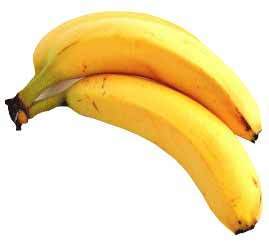 This year is (roughly) the 20th anniversary of the publication of EU Commission Regulation (EC) No 2257/94. So what better time to take another look at ‘Laying down quality standards for bananas’. The regulation caused, and continues to cause debate centering around the acceptable curvature of bananas – which some now cite as a standard example when trying to illustrate effects of what they see as bureaucratic meddling. For instance: ‘Farewell to bendy bananas’ (This is Money, 20 January 2005 )
This year is (roughly) the 20th anniversary of the publication of EU Commission Regulation (EC) No 2257/94. So what better time to take another look at ‘Laying down quality standards for bananas’. The regulation caused, and continues to cause debate centering around the acceptable curvature of bananas – which some now cite as a standard example when trying to illustrate effects of what they see as bureaucratic meddling. For instance: ‘Farewell to bendy bananas’ (This is Money, 20 January 2005 )
However … a careful Improbable reading of the regulations reveals that there is definitely no statement specifying exactly how curvy bananas should or should not be – other than a blanket and indefinite declaration that they must be : “Free from malformation or abnormal curvature of the fingers.” But exactly what constitutes ‘abnormal’ remains undefined.
The regulation document does have some other important information – such as the correct way to measure the length of a banana:
“The length of the fruit expressed in centimetres and measured along the convex face, from the blossom end to the point where the peduncle joins the crown. […] The minimum length permitted is 14 cm”
And, the quantity in bunches:
“The bananas must be presented in hands or clusters (parts of hands) of at least four fingers. Bananas may also be presented as single fingers.” Meaning, we believe, that bananas can be sold in any number as long as it’s not 2 or 3.
Note: Rumour has it that the so-called ‘Bent-Banana’ rules are to be, or maybe even have been, scrapped – but Improbable has been unable to verify this.
Plenty more: Improbable bananas research can be found here.
A rock, a paper, a scissors, a bunch of lizards
Hannah Fry, in this Numberphile video, tots up the cases of rock-paper-scissors mathematics as applied to lizards:
This goes back, more or less, to a sex study published in the year 2000:
“Polygyny, mate-guarding, and posthumous fertilization as alternative male mating strategies,” Kelly R. Zamudio and Barry Sinervo, PNAS, 2000 97 (26) 14427-14432.
Here’s a photo of rock-paper-scissors/lizards researcher Kelly Zamudio, of Cornell University, sitting on a pile of sand with a colleague:
January 29, 2015
Exit strangely, mathematician
Peruse, if you will, the Rutgers catalog of mathematicians who had strange and/or colorful deaths. Kellen Myers is the keeper of same.
(Thanks to investigator Ginny Lewis for bringing this to our attention.)
January 28, 2015
How many drinks does it take you to feel drunk?
The answer, it seems, depends on many factors. Gender for example, and also when you ask(ed) the drinkers. A report in the journal Addiction, (Volume 101, Issue 10, pages 1428–1437, October 2006) examined the 1979, 1995 and 2000 US National Alcohol Surveys, and found that :
“
The mean reported number of drinks to feel drunk declined significantly between each survey and was significantly lower for women. Considerable variation was also found within surveys and was explained partially by available variables. Volume of alcohol and heavy drinking occasions were associated positively with the number of drinks to feel drunk.”
In the latest survey (2000) the number of drinks to feel drunk was roughly 6.5 for men and around 4.5 for women. Sadly, the abstract of the paper doesn’t specify another important factor; viz. what, exactly, were the drinks?
See: ‘How many drinks does it take you to feel drunk? Trends and predictors for subjective drunkenness’
Further info on the study here, courtesy Prof. David J. Hanson, Professor Emeritus of Sociology of the State University of New York at Potsdam.
[Image taken from page 158 of ‘Hood’s Own: or, Laughter from Year to Year’, 1855, courtesy The British Library]
January 27, 2015
Judging who, or what, judges people best
This week’s Gestalt Which-of-These-Alternatives-Do-You-See? Question asks you to look at a newly published study.
The question is: What, exactly, is this study judging?
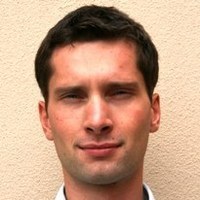 The study is “Computer-based personality judgments are more accurate than those made by humans“, Wu Youyou, Michal Kosinski [pictured here], and David Stillwell, Proceedings of the National Academy of Sciences, epub January 12, 2015. The authors are at the University of Cambridge, UK, and Stanford University in California.
The study is “Computer-based personality judgments are more accurate than those made by humans“, Wu Youyou, Michal Kosinski [pictured here], and David Stillwell, Proceedings of the National Academy of Sciences, epub January 12, 2015. The authors are at the University of Cambridge, UK, and Stanford University in California.
What is being judged? The choices are:
The good judgment of certain computer programs
The bad judgment of many human beings
Something else
BONUS: Video of Monty Python‘s Argument Sketch performed with two vintage speech synthesizers:
BONUS: Video of Monty Python’s Argument Sketch performed with Monty Pythons:
January 26, 2015
Not as bad as you think … [a possibly cheerful collection of same]
Pessimists, maybe it’s time to cheer up! Things are not (always) as bad as you think. See for example :
• The forward premium anomaly is not as bad as you think
• Exchange rate models are not as bad as you think
• The international diversification puzzle is not as bad as you think
• The Feldstein-Horioka puzzle is not as bad as you think
• The allocation puzzle is not as bad as you think
January 25, 2015
Improbable doings in Vienna this coming week
The organizers posted a sneak preview of the ‘sneak preview’ event at the University of Vienna on Thursday evening, January 29:
Und hier die nächste Veranstaltung in unserem Rahmenprogramm: Als sneak preview zur Mitternachtseinlage wird Marc Abrahams am Donnerstag, den 29.1., eine seine sehr speziellen Vorlesungen an der Uni Wien halten; auch dies eine Premiere: es handelt sich um den ersten Auftritt von Abrahams in Wien. Marc Abrahams, Schöpfer und treibende Kraft der Ig-Nobel Preise, mit denen die Menschen „erst zum Lachen und dann zum Nachdenken gebracht werden“ (Abrahams), wird einen öffentlichen Vortrag (auf Englisch) zum Ig-Nobel Preis und der Bedeutung der geistvollen Wissenschaftskommunikation geben (Uni Wien, Hauptgebäude, Hörsaal 41, 18.30 Uhr, Anmeldung mit dem Stichwort “Ig-Nobel” unter ball@wissenschaftsball.at).
The main event, of course, is the Vienna Ball of Sciences, on Saturday night, January 31, in Vienna’s City Hall:
The City of Vienna invites the ball season in the Town Hall into a ball of Sciences with the participation of the entire Viennese research and university landscape. The motto of 2015: “Waltz and science.”
The science ball represents the Vienna research landscape in its excellence and diversity.The typical elements of a Viennese ball are combined with references to the Universities of Vienna. International visibility is produced by global stars of the popular science communication.…
Marc Abrahams's Blog
- Marc Abrahams's profile
- 14 followers


